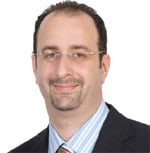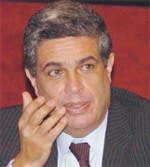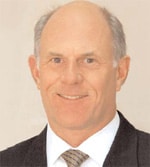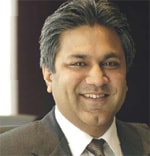While they are wallowing in petrodollars from $60-per-barrel oil, some of the more forward-looking Gulf states are planning to ease themselves off their own addiction to oil..
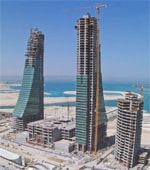
Soaring oil prices have brought a historic transfer of wealth to the countries of the Middle East. Estimates are that the major oil producers will take in more than $300 billion from hydrocarbon exports in 2005 and 2006. While the details differ from country to country, this wealth is being spent on roads, ports, hospitals, schools and other infrastructure. Another major chunk is going into investments at home in real estate and local stock markets. Abroad, investments are being made in the United States, Europe and Asia and include US treasuries as well as real estate in Paris, London and New York.
However, for the first time, Arab investors, who once invested their petrodollars abroad or in T-bills, are returning to the Middle East, eager to seize the next big investment opportunity in what is still a relatively untapped market. The paradigm is shifting, and
an opportunity is being created in emerging markets, says Arif Naqvi, executive vice chairman and CEO of Dubai-based Abraaj Capital. I dont think it is a temporary phenomenon. There is a lot of liquidity that is driven in part by high oil prices and the strong performance of stock markets, but it is also driven by the fact that Arab investors have begun to realize it is easier to invest closer to home.
But it is not just Arab investors that are turning their focus to the Middle East. International institutional investors are also eyeing the market seriously for the first time, as witnessed by the recent round of fundraising for Abraaj Capitals second Buyout Fund (ABOF II), the largest fund ever to be raised in the Middle East. Investor demand for the fund reached $900 million, although the fund eventually closed at its original target of $500 million.
In addition to interest from high-net-worth individuals and family investors, for the first time the fund attracted international institutional investors, which contributed 60% of the total funds raised. There is a perception of growing maturity in the region, Naqvi comments. He believes that the renewed focus on corporate governance and implementing a transparent and world-class regulatory infrastructure is transforming institutional investors perceptions of the region.
It wasnt always that way, though. The regions continued reliance on oil, aid and other strategic rents allowed it to delay implementing deeper and more difficult reforms, says Mustapha Nabli, chief economist, Middle East and North Africa, at the World Bank. The low levels of FDI the region historically attracted mirrored the regions oil dependency. Between 1984 and 1998, according to World Bank figures, FDI constituted less than 1% of GDP in the Middle East, compared to 3% to 4% in most other developing countries.
The publication of the first Arab World Competitiveness Report in 2002, which stated that 100 million jobs would need to be created by 2017 just to maintain the same levels of employment that exist today, was a wake-up call to the region. The biggest challenge the Middle East now faces is finding economically self-sustaining ventures that will keep the population meaningfully employed. And over time this problem will become exacerbated, as populations within the region are growing at a much faster rate than the developed world. The UN predicts that the population of the oil-rich Gulf Cooperation Council countries, including Kuwait, Qatar, Oman, Saudi Arabia, Bahrain and the United Arab Emirates, will increase more than half by 2025, compared to a 3% increase in the more developed countries.
There are questions, however, about where the economic and employment growth will come from, and whether the region can continue to rely on high oil prices to sustain future growth. One day, oil may run out, and over the next five years oil prices are predicted to drop to $25 to $30 a barrel. Adel A. El-Labban, group CEO of Bahrain-based Ahli United Bank, asks: What do you do with the revenue? What are the areas of local investment that are sustainable at the time when revenue and demand will adjust to reduced oil prices or at least their rate of increase? This represents both a great opportunity and a great risk.
|
Oil and Beyond |
||||
Several countries within the Middle East are trying to free themselves from their dependence on oil. The regions two most dynamic business models at present are Qatar and Dubai, El-Labban says. Qatar has oil, but estimates are it will run out in about 50 years at current production levels. But Qatar also has gas, and lots of it: It took in 35% of total export revenues from gas in 2004 and expects that proportion to grow to 50% by 2009. A major advantage is that gas is sold with long-term contracts, which are subject to price re-sets that are only partially dependent on the price of oil. It is estimated that the gas will last for 200 years at planned production levels.
Qatar has focused on the gas and gas derivates side of the business. It is also reportedly the only Gulf state investing in technologies that convert gas to liquids (GTL), in a $900 million joint venture between Qatar Petroleum and Sasol of South Africa. Development is also due to commence this year on Qatars $3.5 billion Dolphin project, which will supply gas from the offshore North field to Abu Dhabi and Dubai via an undersea pipeline. Qatar took a strategic decision to allow foreign investment in oil and gas, explains Ali Sherif Al-Emadi, the acting CEO of Qatar National Bank, Doha. The production numbers show the positive results of that policy: The top names in the industry all have major investments. The whole nation has changed. In an effort to service Qatars burgeoning LNG and oil businesses, Qatar Financial Center (QFC) launched in May 2005. It provides companies with 100% ownership and repatriation of profits as well as generous tax breaks. Explaining the reasons for the development of QFC, its director-general, Stuart Pearce, says: Qatar will invest $33 billion to $35 billion in its economy in the next five years. We have been set up to build capacity in finance to help manage this process. Dubais efforts to diversify away from oil have been more multifaceted, including tourism, transit, shopping, finance and real estate development. According to UNCTAD, liberalization of the real estate sector in Bahrain and UAE is driving an
intraregional investment boom in construction and tourism, which resulted in FDI inflows to the region increasing from $6.5 billion in 2003 to $9.8 billion in 2004. Dubai has established development zones such as Dubai Health Care City and Internet City, free-trade zones with special incentives for media, healthcare and technology companies.
Recent trends in global energy prices have allowed some countries within the GCC to strategically diversify their economies and reduce dependence on oil [on a relative basis], comments Omar Kamal, executive manager of Ernest & Youngs Bahrain-based Islamic Financial Services Group. Dubai Ports Worlds recent purchase of P&O; is a case in point. Dubais Ports, Customs & Free Zone Corporation (PCFC) aims to create one of the worlds largest port operators and recently issued a $2.8 billion sukuk, the largest sukuk in the history of Islamic banking, lead-managed by Dubai Islamic Bank and Barclays Capital. Last November the Dubai Gold & Commodities Exchange (DGCX), the first electronic multi-commodity derivatives exchange in the Middle East, opened for business. A joint venture between the Dubai Multi Commodities Centre (DMCC), Financial Technologies (India) Ltd (FTIL) and the Multi Commodity Exchange of India Ltd (MCX), the DGCX started trading gold futures and was scheduled to have added silver futures by the end of March, as well as other commodity-based contracts such as cotton and energy by the end of the year. The fact that we have attracted 200 members, mainly from the UAE, India, Pakistan, London and New York, gives some indication of the demand locally and regionally for this product, comments Colin Griffith, the DGCXs chairman. |
|
Financial Services |
|
Bahrain, although not as rich in resources as some of its neighbors, was one of the first countries in the region to start shaking off the shackles of oil dependence. It is the oldest and most well-established financial center in the region. By the end of 2004 there were 367 licensed financial institutions in Bahrain, comprising 189 banks, 165 insurance firms and 13 capital market brokers.
Bahrain got its big break in the 1970s and 1980s at the expense of Lebanon when war and violence forced most bankers out of that country. Bahrain was receptive, creating a regulatory environment that attracted banks from around the world. And Bahrain hasnt let up. It is pushing to become a leading center for Islamic finance, particularly with respect to pioneering Shariah-compliant takaful (insurance). Bahrain has a first-mover advantage as it was one of the first Islamic financial hubs in the world with a solid regulatory infrastructure. However, the market is becoming more competitive as cities such as Doha and Dubai try to position themselves as key regional financial hubs, says Kamal. Bahrain is also leading the way in terms of the development of well-capitalized Islamic banks, with the $111 million IPO of Al Salam Bank and Al Baraka Banks $450 million IPO. Yet, unlike Dubai and Bahrain, Qatars efforts to become a major financial hub in the form of the QFC are less focused on Islamic financing and more on providing financial expertise and incentives for companies investing in the countrys oil and gas resources. |
|
Setting an Example |
||
Other GCC countries are also beginning to follow Qatar, Bahrain and Dubais example. In an effort to attract foreign investment for non-oil-related projects, Saudi Arabia has made it easier and more transparent for foreign investors to do business there. It is wrong to think of Saudi as simply an oil producer, says John Coverdale, managing director, Saudi British Bank (SABB). Saudi exports a considerable amount of goods, everything from carpets through to jewelry.
Saudi Arabia has also streamlined application procedures for business licenses and visas and instituted a new law for investment in mining. Further liberalization is anticipated with Saudi Arabia gaining entry to the World Trade Organization. Coverdale says the ease of doing business in the region has improved markedly. On the World Banks 2006 ease of doing business index, Saudi Arabia is ranked 38 out of 155 countries, the highest of any Middle Eastern country. In February SABB launched a new bank logo, the hexagon used by HSBC, which has a 40% stake in SABB. Coverdale says this is symbolic of HSBCs commitment to the Saudi market. Yet with high oil prices resulting in excess liquidity across the region, the question remains, Are there enough investment opportunities to make use of this liquidity? And how successful will these strategies be in inoculating countries such as Qatar, Dubai and Saudi Arabia from the next drop in oil prices? Some are concerned that they will find themselves just as dependent on oil as their neighbors. Kamal says: There is a lack of regional investment opportunities, and, subsequently, domestic real estate and stock markets have absorbed this excess liquidity, resulting in dramatic price increases. Further, governments have encouraged the proliferation of IPOs to tap this excess liquidity; recently, Bahrain-based Al Salam Banks IPO was oversubscribed 62 times. 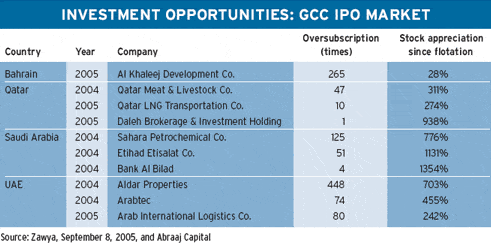 |
|
Open for Trading |
||
Last September the Dubai International Financial Exchange (DIFX) opened its doors with five equity tracker certificates based on international indexes and a GDR by Beirut mobile telecom company Investcom. The exchange hopes that trading activity will pick up in the second quarter of 2006, when it plans to list sukuks, derivatives, futures, options and warrants. Our aim is to achieve between $2 billion and $3 billion market capitalization by 2006, says Dr. Nasser Al Shaali, COO, DIFX. The DIFXs ambition is to retain liquidity and capital-raising opportunities within the region so family-owned companies such as Investcom and UAE jeweler Damas, as well as strategic privatizations, can list and raise capital within their own time zone.
For many years, people said there were not enough exits in the region, but we have successfully exited over 17 investments, says Naqvi of Abraaj Capital. One of Abraajs more notable exits was courier company Aramex (the DHL of the Middle East), which was once listed on the Nasdaq. After acquiring the company, Abraaj IPOed it on the Dubai Financial Market last year, with an anticipated return 5.3 times the value of its initial investment. Abraajs other investments include Maktoob, an Arabic online portal, and JorAMCo, a Jordanian aircraft maintenance company. Naqvi says he is seeing a lot more privatizations across the board throughout the region. Governments are finally selling assets because they realize that they need to be in the business of governing and not in the business of management, he says. Most of the privatizations throughout the region have centered on the telecom, transport & logistics and banking & finance sectors. Saudi telecom company Etihad Etisalats $267 million IPO in 2004, the largest in Saudi history, was oversubscribed 51 times (see table, page 22). Robert Eid, CEO, Arab National Bank, notes, There is a pipeline of IPOs coming through in the Saudi market, and each one sets records compared with the previous one. A good example is the recent IPO of Yanbu National Petrochemicals Co. (YANSAB), which was so popular with potential subscribers that security forces had to be called in to control the crowds on the first day of trading. Eid says this typifies the fundamental change in consumer and investors behavior across the regionan investor feeding frenzy that contributed to the Saudi stock market more than doubling, with 105.5% returns, in 2005. The challenge now for banks is being able to digest and absorb all of the prospective growth, says Eid.  |
Additional reporting by Joseph Giarraputo
